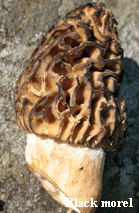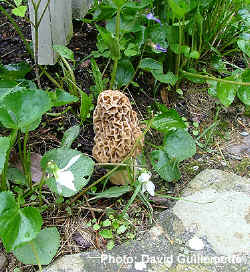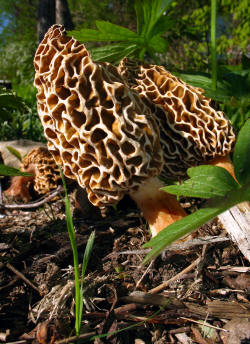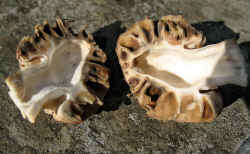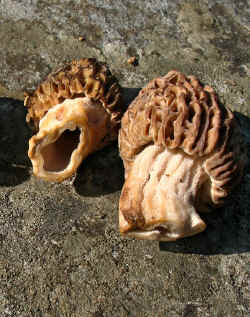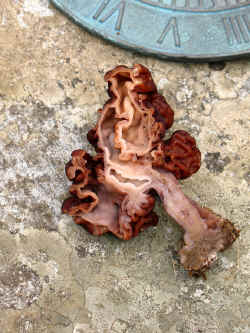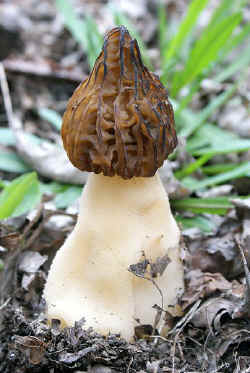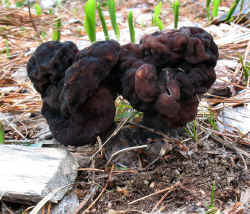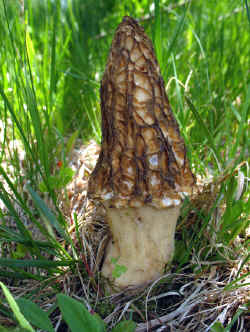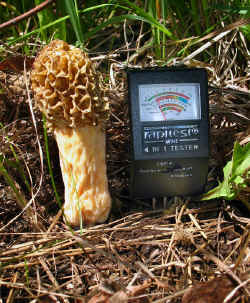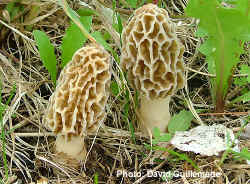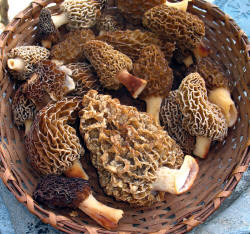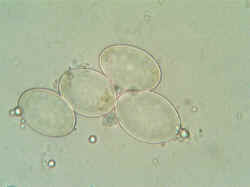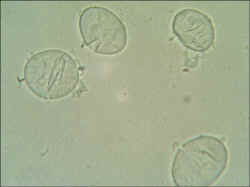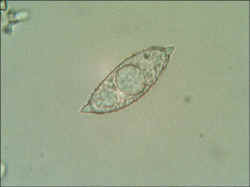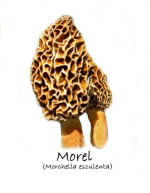|
|
Mushroom-Collecting.com A New England and Eastern Canada Edible and Medicinal Mushroom Resource |
|||||
|
Morels
Beginning in Late April through mid-June morels appear in Maine. Morels are known by some as sponge mushrooms. I don't find many of this one. Morels are uncommon in Maine. They are around though and one of just a few big prizes of the early collecting season. Yellow Morels (Morchella esculenta) seem to predominate. Other species are found rarely. No one is sure how many species there are but generally they will be characterized as black, yellow, or half-free morels. Half-free morels (Morchella semilibera) and Black morels (Morchella elata), (if there are any) are likely to appear first followed by the yellows. Morel sp. grow throughout the United States. One must be absolutely sure that they have not picked the false morel. They contain a volatile substance known as MMH (monomethyl hydrazine) that is similar to rocket fuel. Some parboil it and do eat it. Don't even think about it. MMH is much more carcinogenic than benzene. There have been numerous poisonings and a few deaths. No false or questionable morel should ever be eaten. False morels are a fairly common find for me. They grow all over my yard. They like my wood chips and red pines. Fruit body Morels have attached caps that are honeycomb or sponge-like on a short sometimes thick whitish stem. The cap is never wavy or brain-like. Normal size is 1-5 in tall. Sometimes they can be much larger. All true morels are completely hollow. Cap (pileus) The yellow morel cap is usually conical, oval, bell shaped and sometimes quite irregular with grayish or yellowish ribs (never black or dark brown) and darkish to yellow recesses. Black morel caps are fully attached to the stem and have black or brown ridges and tend to be conical, elongated, or bell shaped. The bottom of the stem may have a small overhang as seen in the photograph of the bisected black morel below. The pits are more in lines between the ridges like corn rows. Half-free morels caps are usually smaller, bell shaped and only half attached. Normal cap size is 1-2 in. wide and 1-4 tall. It looks a bit like honeycomb or sponge and is never wavy or brain-like. Morels are ascomycetes. They produce spores in sacs called asci that are in the recesses on the surface of the cap. No gills or pores are present. Stem (stipe) Whitish, hollow, usually short with ribs or bumps and whitish flesh and a pebbly texture. It can become thick with age or have a bulbous base. When and where to find them (ecology) Morels grow from as early as late April until about the middle of June. Black morels are likely to appear the earliest and are likely to be found under conifers, in the woods, or along woods edges. Late May is when yellow morels are likely to be found in numbers. Morels are commonly found around certain trees but not always. Apple orchards are one of the most likely places to find yellow morels. When the trees are blooming is the most likely time. Unfortunately, many orchards have been sprayed with pesticides year after year with the chemicals eventually entering the soil where they can persist for many years. Morels found in orchards that have been sprayed in the last 10-20 years or more may not be safe to eat. It is safest to find old orchards that are no longer farmed or just old, unmanaged trees. There are actually a lot of old apple trees around here that are getting lost in the hardwoods. Ash trees often support morels in rich woods. Dead or dying elms are another common place to find morels. Some say to look when the bark is just starting to fall off. Mixed woods with beech and oak and other hardwoods sometimes support them. Occasionally they may be found in berry bushes, wood chips, compost, along field edges, walkways, swimming pools, and gardens. Around this area, they are often found in places where there is limestone. They may prefer a more neutral ph. See the photo below of a morel in ph 6.4 soil. Individual fruit bodies in a patch can exhibit some different looks with varying shapes and coloration. Sometimes you hear of a gray morel with light gray ridges and darker recesses. That is actually an immature yellow morel. Preparation These must be cooked thoroughly. Never, ever eat morels raw! They are good sautéed, deep fried, or dried and reconstituted. One of the best ways to eat them is by themselves to appreciate the subtle morel flavor. Morels with brook trout is a favorite. Foods that are not overpowering are best with this one such as chicken, fish, cheese, white sauces etc. They make fine soup. Mixing morels with other mushroom varieties, especially Agaricus sp., would just be a shame. Comments I'm hoping I can go out morel hunting with David this coming spring. We have talked mushrooms for at least 25 years but never hunted together. He finds a lot and I'm sure he can show me some of his tricks. (We have both been a bit secretive over the years). In my town I don't know anyone who has found a morel. I checked every dead elm and old apple tree in town last year with no results. I even checked a burn site even though burn site morels are not known on the east coast. That said, due to extreme dryness, 2007 was a bad year for most all mushroom species growing on the ground in Maine. Closer to the coast, where there is a lot of limestone, people find a fair number. I'm guessing the soil has a more neutral ph. The soil is quite acid a few miles inland where I live. I hope to develop some information on this. False morels are found at the same time of year. They are poison and sometimes deadly. You must be sure to know the differences. False morel caps are irregular and brain-like with a chambered interior. Verpa conica and Verpa bohemica often known as thimble caps bear a passing resemblance to the half-free morel. The cap of Verpa spp. is attached at the very top of the stem like a thimble on the end of a finger. Although some people eat Verpas, there have been some poisonings so Verpa sp. should be avoided. True morels have a more honeycomb appearance to the cap and are completely hollow from top to bottom. Stinkhorns only vaguely resemble morels and yes, they stink. I have attempted to grow some morel patches around my house without success so far. The last time I saw a morel was in a heavily sprayed orchard.
If you like my photography, I have products like tee shirts, aprons,
coffee cups, and other items
available here.
|
